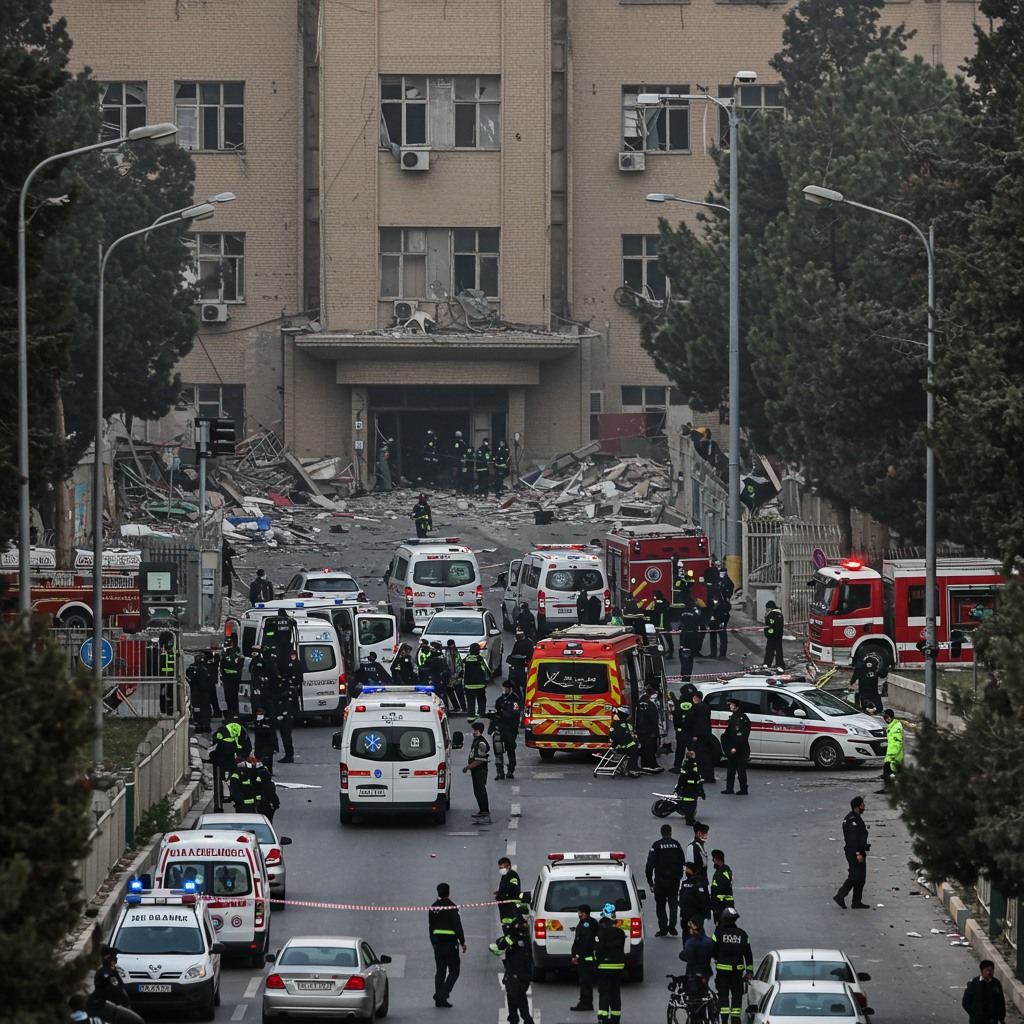In a significant development following recent hostilities, Iran’s judiciary has announced a staggering death toll from an attack on Tehran’s infamous Evin <a href="https://news.quantosei.com/2025/06/29/iran-says-71-dead-in-israeli-strike-on-tehran-prison-this-month/” title=”Shock Claim: 71 Dead in Israeli Evin Prison Strike”>prison. According to judicial officials speaking on Sunday, at least 71 individuals were killed in the strike which occurred on Monday, June 23. The report specified casualties among prison staff, military personnel, inmates, and visiting family members present during the assault. This incident took place just one day before a ceasefire between Israel and Iran officially came into effect, ending a intense 12-day period of conflict. The claims made by Iran have not yet been independently verified by external sources.
Details of the Devastating Evin Prison Attack
The statement from judiciary spokesperson Asghar Jahangir, shared via the official Mizan news agency website, provided chilling details. He reported that the Israeli attack specifically targeted several key areas within the large prison complex. These included the facility’s infirmary, essential engineering buildings, sections handling judicial affairs, and critically, the visitation hall. It was in the visitation hall where Iran alleges visiting family members were tragically among those killed or injured during the bombardment. Providing independent confirmation of these precise casualty figures or the specific locations hit has been challenging in the immediate aftermath.
The rationale behind Israel potentially targeting a prison remains unclear. On the day of the strike, Israel’s Defense Ministry issued a general statement. It indicated that its forces were attacking “regime targets and government repression bodies in the heart of Tehran.” News of the strike on Evin Prison was largely overshadowed later that same day. A subsequent Iranian missile attack on a U.S. base in Qatar, which resulted in no casualties, quickly dominated headlines. Furthermore, the pivotal announcement of the pending ceasefire also shifted global attention away from the prison incident.
Human Toll and Notoriety of Evin Prison
The loss of life reported by Iran highlights the profound human impact of the conflict, even beyond military targets. Among those killed were individuals serving time or working at the facility. Crucially, the judiciary’s statement notes the presence and deaths of family members during visiting hours. This detail underscores the vulnerability of civilians near or within structures that become targets. While specific numbers for each group were not released, the overall figure of 71 suggests a widespread impact within the prison grounds. Iran reported that some injured individuals received immediate medical attention at the prison site. Others with more severe wounds were transported to nearby hospitals for further treatment.
Evin Prison holds significant symbolic weight within Iran and internationally. It is widely known as a facility where political prisoners, human rights defenders, and dissidents are held. For decades, it has been viewed as a potent symbol of the Iranian regime’s approach to suppressing dissent and opposition. The death of top prosecutor Ali Ghanaatkar in the attack was confirmed by Iran on Saturday. Ghanaatkar had gained notoriety for prosecuting numerous dissidents. His cases included the prosecution of Nobel Peace Prize winner Narges Mohammadi. This history had drawn significant criticism from global human rights groups. A large public funeral procession was reportedly held in Tehran for Ghanaatkar and approximately 60 other individuals killed in the strike.
Human Rights Concerns and Responsibilities
The attack on Evin Prison immediately drew sharp criticism from international human rights organizations. The New York-based Center for Human Rights in Iran (CHRI) swiftly condemned the strike. The group argued that by hitting a facility primarily known for housing prisoners, Israel potentially violated international humanitarian law. Specifically, the CHRI cited the principle of distinction. This principle requires warring parties to differentiate between civilian objects and military objectives and avoid targeting civilians. Striking a prison, even if it houses some individuals connected to the state, raises serious questions under this principle.
However, the CHRI also directed criticism towards Iranian authorities. The organization stated that Iran had a legal obligation under international law to protect the prisoners in its custody. The CHRI specifically slammed Tehran for what it described as a “failure to evacuate, provide medical assistance or inform families” in the aftermath of the attack. This dual criticism underscores the complex legal and ethical dimensions of the incident. It highlights the responsibilities of both attacking and defending parties during armed conflict, particularly concerning the safety of detained populations and civilians.
Broader Context of the Israel-Iran Conflict
The strike on Evin Prison occurred within the larger framework of a brief but intense 12-day conflict between Israel and Iran. The Associated Press has characterized these exchanges as a “war” due to their scope, intensity, and duration. The hostilities reportedly began on June 13 with a major Israeli bombing campaign. Israel stated its primary objective was to dismantle Iran’s nuclear program. Tehran has consistently denied that its nuclear activities are aimed at developing weapons.
During this 12-day period before the June 24 ceasefire, Israel made several claims regarding its military successes. It stated it had killed around 30 Iranian commanders and 11 nuclear scientists. Israel also claimed to have struck eight nuclear-related facilities. Additionally, it reported hitting more than 720 military infrastructure sites across Iran. Casualty figures from this period are contested. The Washington-based Human Rights Activists group reported that over 1,000 people were killed in Israel’s strikes, including at least 417 civilians. Iran responded to the Israeli campaign with its own significant military action. Tehran fired more than 550 ballistic missiles towards Israel. While most were intercepted by defense systems, some missiles penetrated Israeli airspace. These resulted in damage in various areas and caused the deaths of 28 people.
Ceasefire Adherence and Future Tensions
Both Israel and Iran have reportedly adhered to the ceasefire agreement since it took effect on June 24. However, despite the current truce, Iranian officials have voiced skepticism regarding Israel’s long-term commitment to the agreement. This distrust was articulated by Abdolrahim Mousavi, the chief of staff for Iran’s armed forces. Speaking in a conversation with Saudi Arabia’s defense minister, Mousavi’s comments were reported by the Iranian state TV agency IRNA.
“We did not initiate the war, but we responded to the aggressor with all our might,” Mousavi was quoted as saying. He added, “Since we have complete doubts about the enemy’s adherence to its commitments, including the ceasefire, we are prepared to give them a strong response if they repeat the aggression.” This statement signals Iran’s readiness for potential renewed conflict. It highlights the underlying tension and lack of trust that persists between the two regional adversaries, even in the wake of a declared halt to hostilities. The future stability of the ceasefire appears to rest precariously on mutual adherence and the potential for further provocations.
Status of Iran’s Nuclear Program Remains Uncertain
A key instigating factor for the recent conflict was Israel’s stated goal of destroying Iran’s nuclear program. As of Sunday, uncertainty still surrounded the actual status and extent of the damage to the program. Conflicting reports emerged from both sides. U.S. President Donald Trump asserted that American strikes had “obliterated” the program. However, Iranian officials dismissed this claim, calling it an exaggeration of the actual impact.
Adding an expert perspective, Rafael Grossi, the head of the International Atomic Energy Agency (IAEA), discussed the situation in a televised interview. Grossi stated that while there was undoubtedly “severe damage,” it was “not total damage.” He emphasized that Iran still possesses the necessary “industrial and technological capacities.” This means Iran could potentially resume nuclear activities if it chose to do so. However, Grossi stressed that a full assessment of the timeline for recovery or the precise extent of the damage is currently impossible. This is because Iranian officials have not yet permitted IAEA inspectors access to the relevant sites. The lack of transparency surrounding the nuclear facilities post-strike leaves the international community with an incomplete picture. It fuels ongoing concerns about Iran’s nuclear capabilities moving forward.
Frequently Asked Questions
How many people did Iran claim were killed in the Israeli attack on Evin Prison?
According to a statement from Iran’s judiciary spokesperson Asghar Jahangir on Sunday, June 29, at least 71 people died in the attack on Evin Prison. The judiciary reported that those killed included prison staff, soldiers, inmates, and members of visiting families who were present at the time of the strike on Monday, June 23. However, these figures have not been independently confirmed.
Where is Evin Prison located, and why is it considered notorious?
Evin Prison is located in Tehran, the capital city of Iran. It is widely known as a notorious facility primarily used to hold political prisoners, journalists, human rights lawyers, and dissidents. The prison has a long history associated with the suppression of opposition voices in Iran and is often seen as a symbol of the Iranian regime’s human rights record and approach to political dissent.
What was the broader context surrounding the alleged Israeli strike on Evin Prison?
The attack on Evin Prison on June 23 occurred the day before a ceasefire took effect between Israel and Iran. It took place during a 12-day period of intense military conflict initiated by Israeli strikes aimed at Iran’s nuclear program. The prison attack happened on the same day Iran launched missiles at a U.S. base in Qatar, and news of the incident was largely overshadowed by the ceasefire announcement.
Conclusion
The alleged Israeli strike on Tehran’s Evin Prison, as reported by Iran’s judiciary, adds a tragic and complex layer to the recent conflict between the two nations. Iran’s claim of at least 71 fatalities among a diverse group including prisoners, staff, soldiers, and visiting families paints a grim picture of the incident’s impact. While the casualty figures await independent verification, the attack on a facility housing political prisoners has drawn significant condemnation from human rights groups, who also criticized Iran’s handling of the aftermath. Occurring just before a ceasefire, the strike underscores the intense nature of the brief war, which also saw significant attacks on nuclear-related and military targets. As both sides adhere to the truce but remain suspicious of each other’s intentions, and with the status of Iran’s nuclear program still uncertain, the incident at Evin Prison serves as a stark reminder of the volatility and human cost inherent in the ongoing regional tensions.



